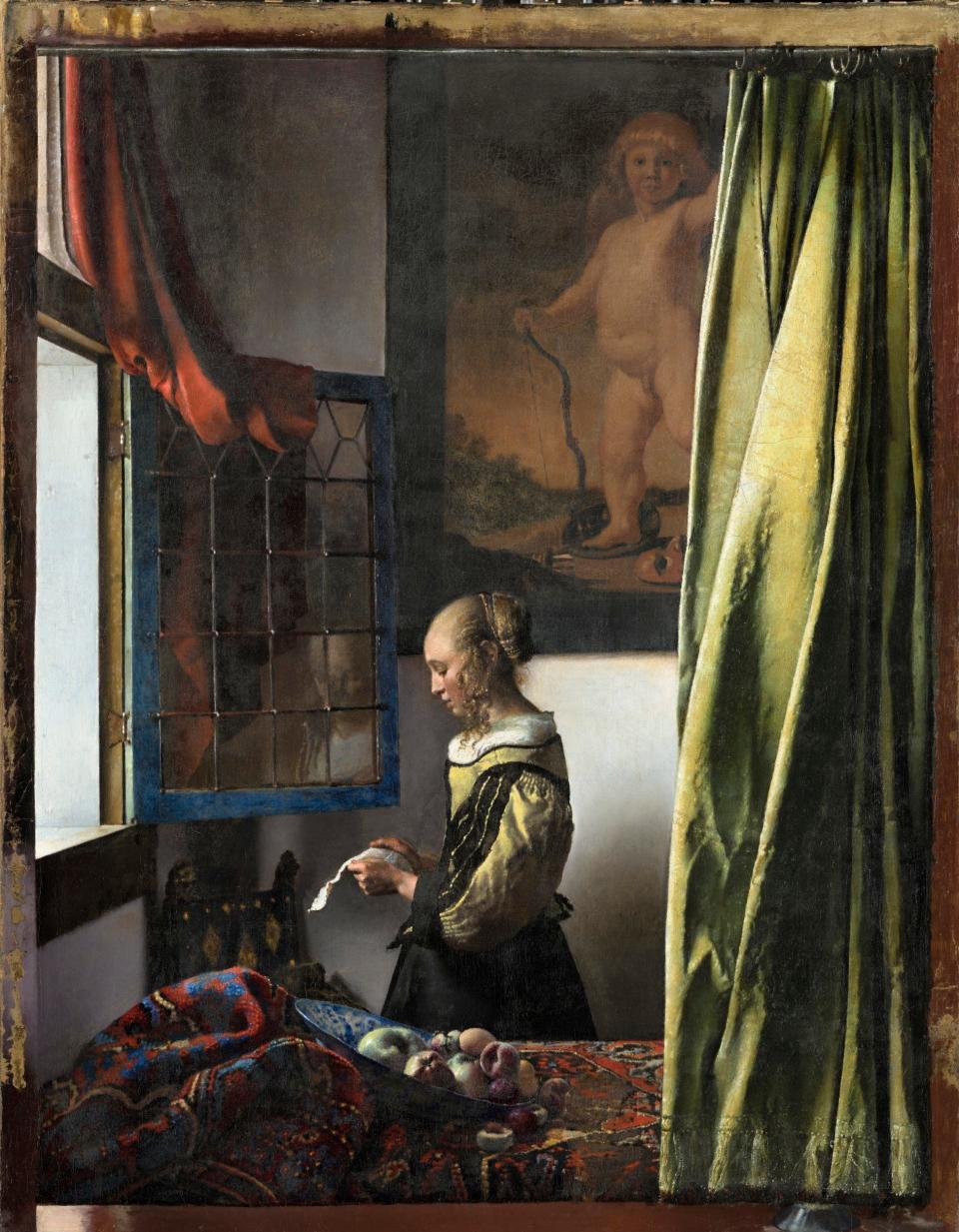Vermeer: a painter of exquisite artificiality and creepy men

Hush! Settle down. We are in the presence of Great Art. That is the message conveyed by the stately décor inside the new Vermeer exhibition at the Rijksmuseum in Amsterdam. Dark walls. Floor-to-ceiling drapes, like something out of a funeral parlour, throwing to those theatrical swags frequently used by the artist as a compositional device.
And the pictures? Like preachers in the pulpit, they appear behind semi-circular balustrades, each accompanied only by a title and date. Vermeer converted to Catholicism, but, here, there’s a Protestant directness to the relationship between viewer and art. A milkmaid preparing bread pudding; well-to-do women reading and writing letters, fiddling with jewellery, flirting, making music: the subjects of these paintings, from the third quarter of the 17th century, are so well known, it seems, they require no explanation. This is art as immaculate conception. Time to worship. Even contrarians hardwired to quibble – and there are criticisms one could make, for instance of the themes, at times almost whimsical, by which the paintings are arranged – must concede that this is a profound cultural event. Born in the Dutch city of Delft in 1632, Johannes Vermeer probably executed no more than around 45 pictures before his death in 1675. Of these, approximately 37 have survived, of which 28 have been assembled at the Rijksmuseum – including, exceptionally, all three works from New York’s Frick Collection (currently closed for renovation). The last Vermeer show of comparable scope, which opened in Washington in 1995, had around 20 paintings by the master. So, however you slice it, this is a coup. It won’t be repeated.
An introduction promises to bring Vermeer “closer” than before. Certainly, we now know more than ever about this supposed enigma. He didn’t paint slowly; his principal patron was likely a rich former neighbour, Maria de Knuijt. He’s no longer the “sphinx of Delft”.
Foolishly, I thought I knew Vermeer backwards, but seeing his paintings together confounds expectations. His reputation as a realist is a misconception: many passages in his pictures are almost abstract. And, although we still think of him as a painter of “everyday” scenes, his compositions aren’t 17th-century snapshots. Rather, they’re suffused with artificiality and a sense of playacting.
Those gobstopper-sized pearls, for instance, are as fake as paste; the trim on a glorious yellow jacket, which keeps popping up, is pimped-up rabbit fur, not regal ermine. The Girl from the Mauritshuis wears a turban; another from Washington sports a dashing red hat straight from the dressing-up box. In a context of artistic minimalism and restraint, it offers a swoonsome pictorial splurge.

Then, there’s the scale of Vermeer’s paintings, which keeps changing abruptly: why? And, most unnerving of all, a recognition that this master of light excelled at darkness. A chair with distinctive lion-headed finials is silhouetted in the foreground; an officer’s wide-brimmed hat sucks us in like a black hole, a halo’s opposite. Maybe I’m guilty of seeing it through an anachronistic MeToo prism, but, in my mind, Vermeer’s oeuvre is transformed by this exhibition. “Love” is supposedly his theme, signalled by all those coquettish interactions and billets-doux, as well as the paintings of Cupid, like a rampant toddler, which recur on his interiors’ walls. Yet, The Procuress (1656), that supposedly boisterous (but horribly sinister) transitional painting from Dresden, in which a soldier in red gropes a sex worker, provides the key.
Is it me, or are most of Vermeer’s men like this, i.e. predatory and creepy, with only one thing on their mind? A girl laughs (nervously?) before an officer who doesn’t appear to be cracking a joke, his powerful, even menacing, stature amplified by proximity to the viewer. In The Glass of Wine (c.1659-61), the 17th-century equivalent of a date-rape drug is being administered: clamped, muzzle-like, over a young woman’s uncertain face, the vessel practically consumes her, not the other way around. Like many of Vermeer’s “juffrouwen”, she is a lamb before a wolf. And sometimes, when they stare straight at us, that wolf is us.
Hence, perhaps, those open windows: chinks, promising escape. So often, Vermeer’s reticent women are mentally elsewhere. Behind them, the ambiguous, chaotic forms of maps and paintings are like thought bubbles – or cries for help. Yes, these are pictures about transcendence – but in the form, surely, of redemption from society’s vice-like expectations. Each figure is a songbird aching to flee its cage. A depiction of the Last Judgement, in the background of Woman Holding a Balance (c.1662-64), explicitly introduces an apocalyptic note. Nearby, in Allegory of the Catholic Faith (c.1670-74), there’s blood upon the floor. Isn’t Vermeer supposed to be the painter of tranquillity? Here, he comes across as darker than we’d thought.
From Feb 10-June 4; rijksmuseum.nl

